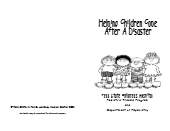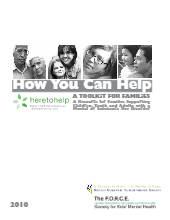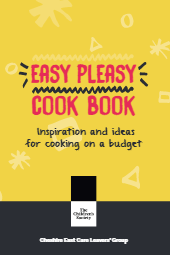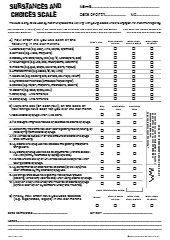Disaster Busters! A Disaster Preparedness Activity Book
“Disaster Busters! A Disaster Preparedness Activity Book” is an engaging educational tool aimed at children aged 6 to 10. Created by the Citizens’ Disaster Response Center, it uses fun activities to teach children about natural disasters like storms, floods, and earthquakes, empowering them with knowledge on how to stay safe. This book is perfect for parents, guardians, and teachers looking to introduce disaster preparedness in a child-friendly way, making learning about safety enjoyable and interactive.
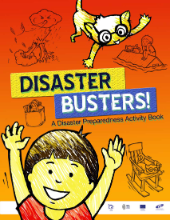
Disaster Preparedness Activity Book
This activity book by Disney and the American Red Cross introduces children to the basics of disaster preparedness through beloved characters like Mickey Mouse and friends. This engaging book covers essential safety steps for various natural disasters, such as floods, tornadoes, earthquakes, and fires, using fun games and puzzles to reinforce learning. Each section encourages children to work with their families to create emergency plans and prepare disaster supply kits, making safety education accessible and enjoyable for young readers.
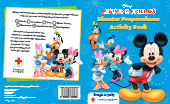
Helping Kids Cope After Emergencies
This booklet is designed to support children in processing their feelings after emergencies, such as fires, floods, or storms. It provides gentle activities and prompts to help kids express their emotions, understand their experiences, and regain a sense of safety. With tools for drawing, writing, and open conversations, this resource encourages children to share their thoughts and feelings in a way that feels comfortable for them.
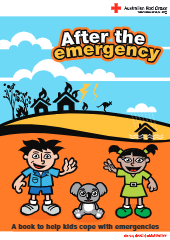
Prepare with Pedro – Disaster Preparedness Activity Book
The activity book introduces young children to essential disaster preparedness concepts. Guided by Pedro the Penguin, kids learn about common hazards like thunderstorms, floods, earthquakes, and wildfires. Engaging activities teach them to identify safe places, create emergency kits, and develop family communication plans. This resource, created by FEMA and the American Red Cross, empowers children to stay safe by learning proactive steps for emergencies.
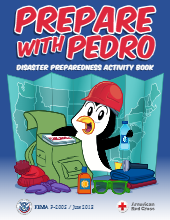
Disaster Preparedness Colouring Book
The resource is designed to help young children understand natural disasters and basic emergency safety through colouring activities. This book covers various disasters like floods, fires, earthquakes, and tornadoes, teaching children essential safety steps, such as recognising warning signs, creating a family disaster plan, and knowing when and how to call for help. With the guidance of a parent or educator, children learn how to stay safe while engaging in fun, hands-on activities that make disaster preparedness accessible and memorable.
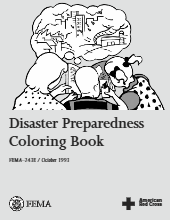
Get Ready! The Book to Help You Prepare for an Emergency
This is an interactive activity book by the Australian Red Cross, designed for young children to learn about emergency preparedness. Through fun activities like drawing, puzzles, and word searches, it teaches kids how to stay safe and respond calmly during emergencies such as floods, storms, and bushfires. This resource encourages children to think about their household emergency plans and provides parents with a gentle way to discuss safety with their children, making emergency readiness engaging and accessible.
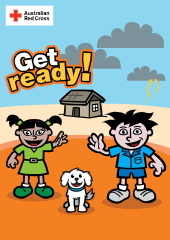
After a Disaster – Children’s Workbook
This workbook helps children process their experiences after a disaster, whether it is a natural event or another traumatic incident. Through drawing, storytelling, and guided reflection, it provides a supportive way for children to express their thoughts and feelings in a safe environment. Designed for one-on-one use with a caring adult, it offers a gentle approach to understanding emotions and building resilience, helping children navigate their journey towards recovery.
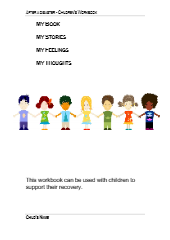
Kids Activity Book: Practice Makes Prepared
This is a fun and educational resource that teaches children about emergency preparedness. Through activities like puzzles, colouring, and matching games, it encourages kids to learn about staying safe during natural disasters and other emergencies. This book also helps children build their own emergency kit and includes interactive ways to understand safety plans, making disaster preparedness approachable and engaging for young learners.
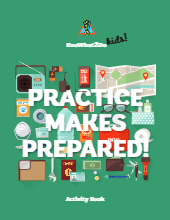
Disaster Activity Book for Kids
This engaging activity book helps children understand and process natural disasters, like floods, hurricanes, and storms. With fun exercises such as drawing, storytelling, and a “Helping Hands” activity, it encourages kids to explore their feelings and learn valuable lessons. Activities like the “Rainbow of Emotions” and “My Disaster Diary” guide children to express themselves, find hope, and feel supported during challenging times.
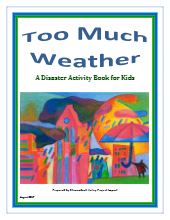
Disaster Preparedness Workbook for You and Your Household
This workbook is a comprehensive guide to help households prepare for emergencies like floods, earthquakes, and power outages. It includes checklists, planning worksheets, and practical tips on creating emergency supply kits, developing evacuation plans, and safeguarding your home. By following these steps, you can better ensure the safety and resilience of your family and household during unexpected disasters.

Let’s Get Ready for an Emergency! – Children’s Activity Book
This is a practical and engaging resource designed to help children understand what to do in various emergencies. Covering scenarios like fires, floods, power outages, and even preparing for long trips, it introduces children to key safety steps through fun activities like word searches, spot-the-difference, and creating emergency plans. With guidance on calling 999, making family emergency contacts, and understanding safety rules, this booklet equips young readers with essential knowledge in a child-friendly way.
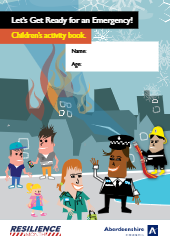
Family Child Care Emergency Plan Workbook
This workbook provides essential tools for family child care providers to create a detailed emergency plan. It includes steps for assessing risks, planning evacuations, and preparing emergency supplies. Specific sections cover creating safe room procedures, fire escape plans, and building kits with food, water, and first aid. This resource encourages communication with parents, ensuring they are informed and engaged in the plan. The workbook is a valuable guide for keeping children safe and ensuring that family child care facilities are well-prepared for emergencies.
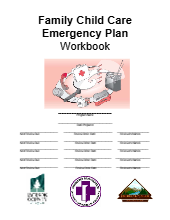
Disaster Preparedness Activity Book for Children
This activity book teaches children the basics of disaster preparedness through engaging stories, puzzles, and interactive exercises. Kids learn what to do in emergencies like thunderstorms, tornadoes, floods, and winter storms, and how to create an emergency supply kit. The book includes practical lessons on staying safe during severe weather, identifying safe places, and understanding the importance of family emergency plans. A valuable tool for helping children feel prepared and confident in handling various emergencies.
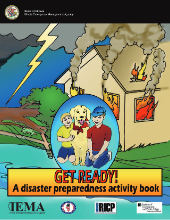
Family Disaster Plan Workbook
This is a comprehensive guide that helps families create a personalised emergency plan. Adapted from the NYCEPCE, it includes structured steps for identifying potential risks, gathering emergency supplies, and establishing communication strategies. This workbook encourages families to prepare for various situations, from natural disasters to utility outages, ensuring they have a clear plan for staying safe. By following the exercises and completing the worksheets, families can improve their readiness and confidently face emergencies together.
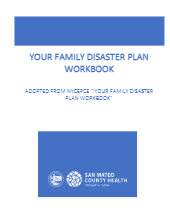
Household Preparedness Workbook
This workbook by the American Red Cross is an interactive guide for families to enhance their emergency readiness. This workbook covers essential preparedness steps, including home fire safety, emergency communication plans, coping skills, and handwashing techniques to prevent illness. It includes practical activities like creating a home fire escape map, setting up emergency contact cards, and choosing meeting spots. Designed to involve both adults and children, this workbook aims to build confidence and resilience within families, helping them respond effectively to various emergencies.
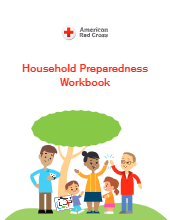
Disaster Plan Worksheet for Families
This worksheet provides a structured approach to creating a family disaster plan. It includes sections on emergency contacts, evacuation procedures, and essential supplies, helping families prepare for fires, earthquakes, and other emergencies. The plan covers steps for staying safe, such as identifying escape routes, assembling emergency kits, and establishing an out-of-area contact. Families are encouraged to personalise the checklist, keep it visible, and review it regularly, ensuring readiness and safety for all household members.
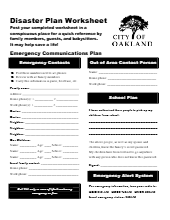
Coping After a Disaster
This activity book by the CDC and American Academy of Pediatrics provides children with tools to understand and manage their feelings after experiencing a disaster. Through relatable characters and engaging activities, children learn that disasters are not their fault and explore ways to cope, such as deep breathing, talking with trusted adults, and identifying supportive people around them. This resource is ideal for parents, teachers, and caregivers to help young ones navigate complex emotions and build resilience in the face of challenging events.

26 Steps Personal Emergency Preparedness Workbook for ADULTS
This workbook by the Campbell Community Emergency Response Team (CERT) offers a comprehensive, step-by-step approach to personal emergency preparedness. Covering essentials like building a go-bag, stocking food and water, and caring for pets, it also includes tips for managing medication, first aid, and hygiene in emergencies. The 26-week guide helps individuals accumulate enough supplies for two adults to last seven days. Designed to make preparedness easy and manageable, the workbook is ideal for those looking to prepare for natural disasters and other emergencies in a structured way.
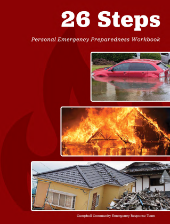
My Emergency Plan Workbook for ADULTS
Created by the Rhode Island Department of Health, this workbook helps individuals and families prepare for emergencies through a structured planning process. It includes steps to build a personal emergency plan, make emergency kits, and create a communication network. The workbook addresses special needs, such as support for children, pets, and individuals with disabilities. By following this guide, you can ensure you have essential supplies, important contacts, and knowledge to stay safe during various emergencies.
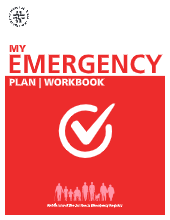
Helping Children Cope with Disaster Guide
The booklet provides guidance for parents, caregivers, and educators to support children during and after disasters. It explains common emotional reactions across age groups, from young children to teenagers, and offers strategies to help children feel safe and understood. Key actions include involving children in creating a family disaster plan, limiting media exposure, maintaining routines, and ensuring children have a sense of control. The booklet also emphasises the importance of open communication, using social support, and accessing professional help if needed, all aimed at fostering resilience and a sense of security.

Tips for Talking to Children After a Traumatic Event
The guide by SAMHSA offers parents and educators advice on supporting children through trauma. It highlights age-specific reactions and suggests strategies to reassure and help children process their emotions, including open conversations, art, play, and maintaining routines. Key points include limiting media exposure, addressing questions at an appropriate level, and encouraging children to express their feelings. The guide also recommends setting up a family emergency plan and engaging children in helpful activities to foster resilience and a sense of security.
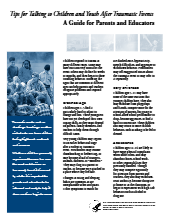
Parent Tips for Helping Preschool-Age Children After Disasters
This guide provides practical advice for parents supporting preschool-aged children after experiencing a disaster. It covers common reactions like fear, confusion, and sleep disturbances, offering ways to comfort children through play, routine, and clear explanations. Parents learn how to reassure their child, help them express emotions, and reduce fear of recurring disasters. This resource is ideal for caregivers seeking ways to provide a safe, understanding environment for young children processing difficult experiences.
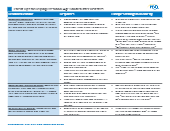
Helping Children Cope After a Disaster
This booklet by Penn State Children’s Hospital provides parents and caregivers with guidance on supporting children emotionally after traumatic events. It explains signs of stress and how children’s reactions can vary by age. Key strategies include reuniting children with caregivers quickly, listening to their concerns, offering consistent routines, and limiting exposure to distressing media. The booklet also advises recognising when professional help may be needed if symptoms persist, helping children build resilience and a sense of safety after experiencing trauma.
